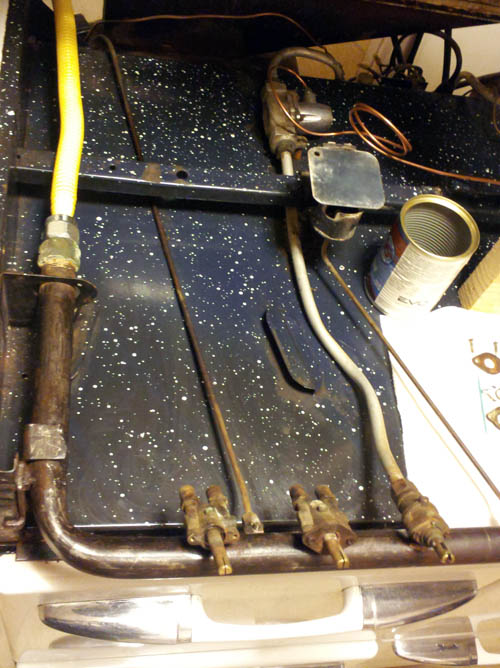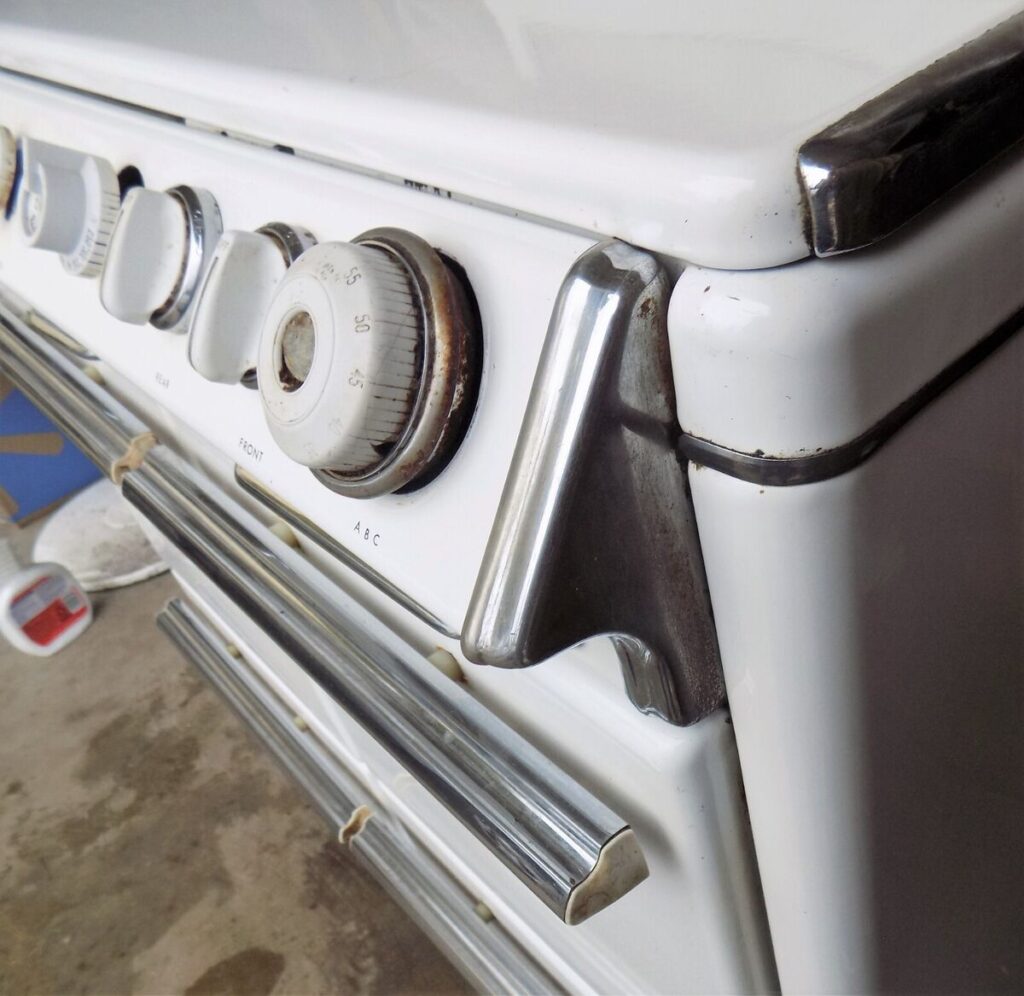

It was months into working on my stove before I discovered the cooktop burner doohickeys that control the flow of gas to the cooktop burners were called Alltrol double valves. My stove has four.
T’was a big puzzle to me at first trying to figure out how I could remove an entire Alltrol valve from the manifold . Information online about how to remove the entire valve? Zilch. Nada. Zip. Bupkis.
How on earth could I remove the valve when the back end of each valve sat well inside the big black tube assembly that carried the gas to the burner heads. And that thing wasn’t budging.
Or so I thought. As familiarity and impatience with my stove grew, my inclination to approach it with delicacy shrank. 🙂 During one attempt to clean the area under the big black tubing, it actually moved! Just a little but enough for me to realized it wasn’t bolted down. Eventually, I realized the entire assembly, while fairly heavy, was simply resting in place and could be lifted up and out of the stove! It couldn’t have been more elegantly simple.




Once one dual burner and tube assembly is removed, by simply lifting it up and out, two Alltrol valves can be unscrewed from the manifold. Well, at least in theory. They’re not easy to unscrew. You might think unscrewing a burner valve wouldn’t be a hassle. Maybe, right after the stove was built. It’s a little different 60 years later. And since they’re brass, which is a soft metal, it was important not to directly apply hardened or steel tools on the valves.
It took some time to find something that would work, at least for me. It’s a spanner wrench and a piece of leather. Go figure. I used the leather to try to protect the valve from the spanner. I assume there are much better tools specially designed for this task. If you know, shout it out!
So I covered the valve with the leather and twisted CCW to get the valve off.


Orifices located on the back end of the valves determine the maximum quantity of gas supplied in the full on position. And yes, the orifice caps were also difficult to remove. Luckily, a wrench worked in this case.
Alltrol Valve Orifices


The orifices have two sizes; the smaller one is for the simmer burner, larger for the main burner. The valve body provides a guide to which cap goes to which opening. On the left and right sides of the valve are two circular indentations. One is much larger than the other which corresponds to the small and larger orifice sizes. A thoughtful touch, isn’t it?



Once I removed the orifices end caps , it was easy to understand how they controlled the gas flow. The fine points come close to fitting into their respective orifice holes. When the orifices are spun to be as close as possible to the points – no gas flow.

The size of the orifice determines the maximum BTU per gas type. The orifices’ valves on my stove were sized for natural gas.
Since propane is more potent than natural gas and butane is more potent than propane, to achieve the same BTU, the orifice sizes for propane needs to be smaller than for natural gas, and smaller still for butane.
Because my Alltrol valves were adjustable, the amount of gas flowing from the caps can vary by screwing the cap closer/further from that pointy (needle) in the valve body.
The O’Keefe & Merritt Tilt-Out

I noticed a couple of the parts stoves I bought had bent Alltrol valves. Pondering these funny valves and how they fit in the stoves made me consider the relationship between the valves, the stoves control panel and the burner assemblies.
Here’s how they go together. To outfit the stoves that have the trademark tilt-out control panel (I love that about this brand), the gas equipment from the manifold to the burners should, somewhere, have the same 37 degree tilt angle. The gas equipment is the combination of valves and the burner assembly. So either the valves or the burner assembly needs to have the 37 degree bend.


My stove has straight gas valves and bent burner assemblies. Other stoves have straight burner assemblies with bent valves. Either combo works for the stoves with the famous tilt-out control panel.
Just guessing on my part, but the bent valves seem to be an older design. The bent valves I’ve encountered so far come from older stove models. Plus, and this is a dilemma for me, the bent valves seen to be made of better stuff. In spite of their age I haven’t found rust on the non-brass parts of the older valves.


